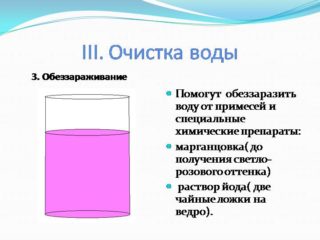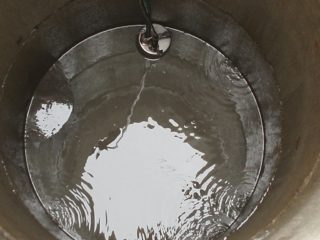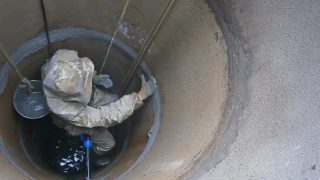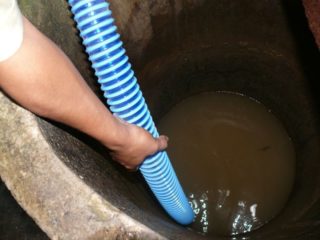Water is the life source of every living organism. The well-being and human health largely depend on its quality. When constructing a well in a household plot, many people imagine how they will drink perfectly clean, cool and tasty well water, but expectations do not always correspond to reality. A common problem is that the water in the source becomes cloudy. It is unsuitable for use, it is necessary to establish the cause of water pollution and take all measures to eliminate it.
Reasons for turbidity after cleaning the well
It is generally accepted that water from the bowels of the earth is healthier than that which flows through a centralized water supply and is chlorinated. This is true, but over time, the fluid from the well can also become cloudy, unpleasantly smelling and have an unpleasant aftertaste. The main reasons for the development of this phenomenon:
- Violation of the tightness of the well rings When arranging a well, reinforced concrete rings are installed on top of each other along its entire depth. The seams between them at the construction stage are sealed with a special solution. After a while, the movement of the soil layers can displace the rings, which leads to depressurization of the joints. If there is dirty water in the well every spring, the reason is precisely this, since snow melting and heavy rains significantly increase the load on the joints.
- Change in the composition of the aquifer. Sometimes contaminants penetrate the source not through depressurized seams, but through the aquifer itself. For example, this can be observed if an industrial enterprise is located nearby, which discharges processed products into natural reservoirs, destroying not only it, but also nearby territories. To deal with this type of pollution is almost impossible, because new waste will again and again pollute the aquifer.
- Liquid content of chemicals or a high concentration of iron. If the water became bright yellow, then industrial wastewater may be the cause, but if the liquid has a slightly yellowish tint, this indicates a high iron content. To eliminate the problem, it is necessary to equip the well with a special cleaning filter.
- Stagnant water is another common cause. Perhaps the source is used less often than it should. Because of this, the water does not renew and stagnates. Organic compounds that penetrate the well from the outside begin to decompose, creating a favorable environment for the development of pathogens.
- Improperly designed or equipped well shaft. For example, the rays of the sun freely penetrate into the well throughout the day, which creates ideal conditions for the development of pathogens. The source must be protected from the ingress of external objects and the rays of the sun. To do this, over the mine can make a canopy or just cover it with a lid.
- Errors when installing the pumping station. Sometimes, the liquid in the well begins to become cloudy only after turning on the submersible pump. Most often, this problem occurs if a vibration pump is installed or is too powerful in a particular case.
If after pumping the well in the spring the water is more cloudy, it is worthwhile, first of all, to check the tightness of the joints and the integrity of concrete rings. These are the main and most common causes of the appearance of turbidity in the well.
Ways to eliminate turbidity in water
If a problem has arisen, urgent measures must be taken to resolve it. First of all, establish the root cause of the appearance of turbidity.
If the water becomes cloudy as a result of lifting from the bottom of the sludge or sand, it is enough to install an additional mechanical cleaning filter. This equipment efficiently traps unwanted impurities and removes them from water.
If the haze is formed after melting snow, heavy rains, we are talking about the depressurization of the annular seams. A complete pumping of water from the well, washing and thorough treatment of the joints with a special solution is necessary.
After the root cause is eliminated, you can begin to work to restore the quality of spring water. The algorithm is as follows:
- Completely pump out water from the well using a pump.
- Armed with a brush with coarse bristles and abrasive particles, lower them into the well and proceed to clean the rings from contamination.
- The entire surface of concrete rings must be thoroughly disinfected.
- Get rid of layers of sand, silt and other debris with a small container.
- Carefully examine the walls of the well. For damage, through holes, the seams should be airtight.
- If during the construction of the well a clay castle was not provided, it must be created.
To prevent re-contamination of the water, it is recommended to mount a bottom filter made of aspen.
Well disinfection
If well water began to deplete unpleasant odors, this indicates an active reproduction of bacteria. The cause of unpleasant odors is hydrogen sulfide, which is released as a result of the vital activity of pathogenic microflora. Such a liquid is unusable.
Well disinfection can be carried out in several ways:
- Cleansing the well with chlorine.
- UV treatment.
The disadvantage of the latter method is the high cost. However, there are advantages - the implementation of the method does not require preparatory work, the taste of spring water does not change.
The source of ultraviolet radiation - special devices that need to be mounted in places close to the place of fluid intake. This method is more often used as prevention than purification.
As for the disinfection of chlorine, unlike ultraviolet radiation, it can adversely affect the well-being and human health. When using a chemical, it is important to strictly follow all prescriptions and the recommended dosage.
You need to work in personal protective equipment: special gloves on the elbow and respirator. Conventionally, the entire disinfection process is divided into three stages:
- Preparatory work.
- Well cleaning.
- Final disinfection.
 For cleaning, chlorine is poured into the bucket and thoroughly shaken with water, poured into the source. After that, it is closed with a lid for several hours. After this time, you can proceed to the final cleaning of the well.
For cleaning, chlorine is poured into the bucket and thoroughly shaken with water, poured into the source. After that, it is closed with a lid for several hours. After this time, you can proceed to the final cleaning of the well.
It is necessary to completely free the source of water and begin to clean the walls, remove mucus and dirt from concrete rings, and from the bottom - silt and accumulated debris. All waste is raised to the surface and disposed of.
It is also important to assess the condition of concrete rings: whether there is damage on their surface, what is the condition of the joints. Defects are eliminated, seams are treated with a special solution. After completing these works, it is necessary that the source is completely filled with clean water.
A disinfecting solution is prepared again at the rate of 200 grams of bleach per 1,000 ml of water. The contents of the container are poured into the mine and left for at least 24 hours. After this time, using a pump, you need to completely pump out the water, treat the walls and pour a large amount of clean water. Several times the water is collected and pumped out.
After disinfection, well water is recommended to be heat treated for the next two weeks.
Preventive actions
The optimal frequency of preventive well disinfection is 1 time per year. The following activities are recommended:
- Making a "house" for the source or roof over it. This will reduce the amount of debris and dust that can be trapped from the outside.
- Arrangement of a clay castle.
- After cleaning, you need to make a high-quality bottom filter. As a rule, flint gravel (10 cm) and a mineral of volcanic origin - zeolite (20 cm) are used. Before laying out the filter, thoroughly rinse the material with plenty of clean water.
These simple preventive measures will not only reduce the frequency of harvesting, but also the rate of appearance of turbidity in spring water.





